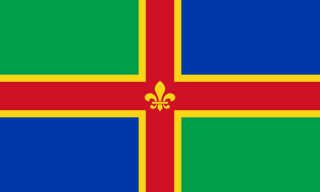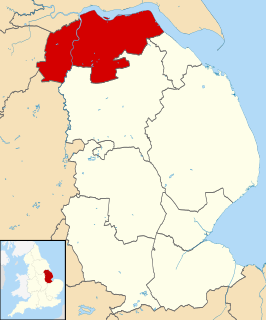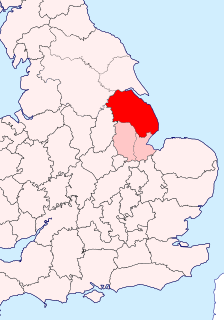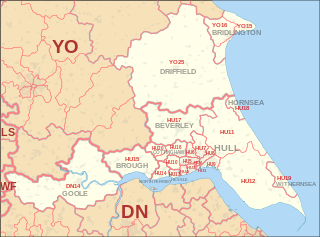
Yorkshire and the Humber is one of nine official regions of England at the first level of Nomenclature of Territorial Units for Statistics (NUTS) for statistical purposes. It comprises most of Yorkshire, as well as North Lincolnshire and North East Lincolnshire. Middlesbrough, Redcar and Cleveland or other areas of the historic county of Yorkshire, are not included. The largest settlements are Leeds, Sheffield, Bradford, Hull, and York. The population in 2011 was 5,284,000.

Lincolnshire is a county in the East Midlands of England, with a long coastline on the North Sea to the east. It borders Norfolk to the south-east, Cambridgeshire to the south, Rutland to the south-west, Leicestershire and Nottinghamshire to the west, South Yorkshire to the north-west, and the East Riding of Yorkshire to the north. It also borders Northamptonshire in the south for just 20 yards (19 m), England's shortest county boundary. The county town is the city of Lincoln, where the county council has its headquarters.

The East Riding of Yorkshire, or simply East Riding or East Yorkshire, is an area in Northern England. The name is traditionally and geographically a reference to the easternmost of the three subdivisions of the traditional county of Yorkshire. The boundaries of the East Riding, the North Riding and the West Riding were historically treated as three separate areas for many cultural and legal purposes, such as having separate quarter sessions. In 1889 under the Local Government Act 1888, administrative counties were formed on the existing historic county boundaries in England, but in Yorkshire, given the vast size of the county area, three administrative county councils were created, based on the historic boundaries of the three Ridings. The East Riding County Council was the administrative local government and ceremonial county (Lieutenancy) area established for the area ; it remained in place for eighty-six years until being removed for new administrative tiers of local government.

North Lincolnshire is a unitary authority area in Lincolnshire, England, with a population of 167,446 at the 2011 census. There are three significant towns: Scunthorpe, the administrative centre, Brigg and Barton-upon-Humber.

North East Lincolnshire is a unitary authority area in the ceremonial county of Lincolnshire in England. It borders the unitary authority of North Lincolnshire and the non-metropolitan county of Lincolnshire, the three areas making up the ceremonial county. The population of the Unitary Authority at the 2011 Census was 159,616. North East Lincolnshire is part of the Yorkshire and the Humber region.

Cleethorpes is a seaside town on the estuary of the Humber in North East Lincolnshire, England with a population of nearly 40,000 in 2011. It has been permanently occupied since the 6th century, with fishing as its original industry, then developing into a resort in the 19th century.

Scunthorpe is an industrial town in the North Lincolnshire borough in Lincolnshire, England. It is the administrative centre of the North Lincolnshire unitary authority, and had an estimated total resident population of 82,334 according to the 2016 census. A predominantly industrial town, Scunthorpe, the United Kingdom's largest steel processing centre, is also known as the "Industrial Garden Town". It is the third largest settlement in Lincolnshire, after Lincoln and Grimsby. The Member of Parliament for Scunthorpe is Holly Mumby-Croft, of the Conservatives.

Humberside was a non-metropolitan and ceremonial county in Northern England from 1 April 1974 until 1 April 1996. It was composed of land from either side of the Humber Estuary, created from portions of the East Riding of Yorkshire, West Riding of Yorkshire, and the northern part of Lindsey, Lincolnshire. The county council's headquarters was County Hall at Beverley, inherited from East Riding County Council. Its largest settlement and only city was Kingston upon Hull. The county stretched from Wold Newton in its northern tip to a different Wold Newton at its most southern point.

The Parts of Lindsey are a traditional division of Lincolnshire, England, covering the northern part of the county. The Isle of Axholme, which is on the west side of the River Trent, has normally formed part of it. The district's name originated from the Kingdom of Lindsey of Anglo-Saxon times, whose territories were merged with that of Stamford to form Lincolnshire.

Glanford was, from 1974 to 1996, a local government district with borough status in the non-metropolitan county of Humberside, England.

Humberside Airport is an international airport at Kirmington in the Borough of North Lincolnshire, England, 10 NM from three large settlements: Grimsby (east), Hull (north) and Scunthorpe (west), on the A18, the latter two places reached by longer roads, in the case of Hull via England's longest bridge that crosses the Humber. It was owned by Manchester Airports Group from 1999 until 1 August 2012, when it was sold to the Eastern Group of companies. North Lincolnshire Council retains a minority of shares in the Airport.

The Barton line is a railway line in North and North East Lincolnshire, England. It runs from Barton-upon-Humber south east to Cleethorpes and was designated by the Department for Transport as a community rail line in February 2007. Barton station is near to the Humber Bridge. It is situated on the south bank of the Humber Estuary.

Metropolitan and non-metropolitan counties are one of the four levels of subdivisions of England used for the purposes of local government outside Greater London and the Isles of Scilly. As originally constituted, the metropolitan and non-metropolitan counties each consisted of multiple districts, had a county council and were also the counties for the purposes of Lieutenancies. Later changes in legislation during the 1980s and 1990s have allowed counties without county councils and 'unitary authority' counties of a single district. Counties for the purposes of Lieutenancies are now defined separately, based on the metropolitan and non-metropolitan counties.

North Humberside is a former postal county of England. It was introduced by the Royal Mail on 1 July 1974, when some addresses were altered in response to the changes in administration brought about under the Local Government Act 1972.

South Humberside is a former postal county of England. It was introduced by the Royal Mail on 1 July 1974, when some addresses were altered in response to the changes in administration brought about under the Local Government Act 1972.

Humberside Fire and Rescue Service (HFRS) is the statutory fire and rescue service covering the area of what was the county of Humberside (1974–1996), but now consists of the unitary authorities of East Riding of Yorkshire, Kingston upon Hull, North Lincolnshire and North East Lincolnshire in northern England.
The history of local government in Yorkshire is unique and complex. Yorkshire is the largest historic English county and consists of a diverse mix of urban and rural development with a heritage in agriculture, manufacturing, and mining. After a long period of very little change, it has been subject to a number of significant reforms of local government structures in modern times, some of which were controversial. The most significant of these was the Local Government Act 1972 and the 1990s UK local government reform. It currently corresponds to several counties and districts and is mostly contained within the Yorkshire and the Humber region.

The three parts of the English county of Lincolnshire are or were divisions of the second-largest county in England. Similar in nature to the three ridings of Yorkshire, they existed as local government units until commencement of the Local Government Act 1972.
The East Riding of Yorkshire is a local government district with unitary authority status, and is a ceremonial county of England. It is named after the historic East Riding of Yorkshire which was one of three ridings alongside the North Riding and West Riding, which were constituent parts a Yorkshire ceremonial and administrative county until 1974. From 1974 to 1996 the area of the modern East Riding of Yorkshire constituted the northern part of Humberside.
















